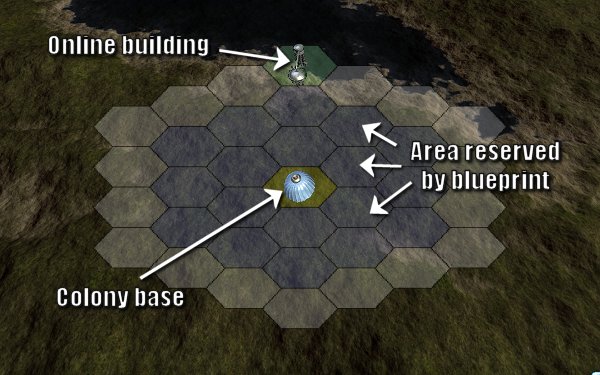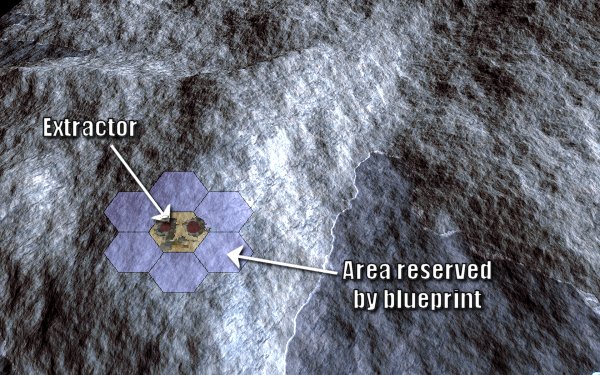This week we did a major design iteration on the planet colonisation system. In the previous design, the planet was split into a huge square grid and you could send scouts anywhere to find resources. Extractors were built on the resources and they were piped to the planet’s main colony for use, so if you found a mineral deposit you’d build a mining station on it and the colony would then have +1 minerals/turn for use in factories.
After some testing, I found that it felt like I wasn’t really colonising the planet; I was just exploring it because I had to get it out of the way, and that’s not fun. Since I could see the terrain and knew where resources would spawn, I tended to go straight for those areas and there wasn’t much left to find in the entire planet. There were also unanticipated problems with designing a reusable colony blueprint: How do you know how many fossil fuel power plants or factories to build if each planet has a different number of resources? And what happens if the blueprint finishes building all your factories but you haven’t found the minerals to supply them yet? This week’s design iteration solved all of the above problems.
Residential cities:
The new design splits the planet up into a hexagonal grid and you can only scout hexagons adjacent to currently explored areas, so you have to explore outward. Unexplored areas are black so you can’t see the terrain, and the hexagons for scouting are huge so you won’t spend forever exploring the planet. Most hexes will be empty, but some will contain resources or suitable locations for additional residential cities. Below is a mocked up image of the city planner:

Tiny planets will have just one viable city location, and larger planets will have several. These cities will be fully independent colonies on the planet, each housing its own population and requiring its own energy generation, military protection etc. All of your important buildings will go in the cities, but it’ll be mostly residential and military. You can have multiple of every building and their effects stack, so you could build nothing but power generators and orbital cannons or mostly housing and entertainment centres to generate tax, it’s up to you. Later in the game, new technologies will give you more space in every city.
Resource gathering towns:
When you find a resource like a mineral deposit or research artifact, you now colonise it with a small industrial town. The town starts with just the extractor building (such as a mining drill or research outpost) and 6 empty hexagons around it that new buildings can be built on. Rather than always sending the resource to the main colony to be used, you can use buildings here to refine it locally and either use the refined product immediately or send it elsewhere for stockpiling. Below is a mock-up of an example town:
In a mineral mining town, you might build an ore refinery, a metal factory, a few power plants and a transport link to an orbital shipyard. This little self-contained town would then send metal to your shipyards each turn, where it’s stockpiled to be used to build ships, missiles, etc. You can build your towns manually or design blueprints to save your designs and help update them later. So you could colonise a uranium deposit and select between blueprints you’ve designed for nuclear power generation, uranium processing for sale, or a nuclear weapons factory and missile silos.
With limited space to build buildings, you’ll have to make tactical trade-offs between money generation, military defense, research and ship production. Do you sacrifice a valuable square to build a shield generator in each towns to protect it from orbital bombardment, or a weapon to help in fleet combat above the planet, or more industrial buildings? I’m leaving it entirely up to the player to decide how to use the system. When it’s done, it’ll have to be tested extensively to make sure there are no clearly overpowered strategies and there’s no single best way to build a colony.
Population control:
Your colonists live in the cities most of the time and are rotated into the towns for work. Cities start with a colony base that houses 1 million colonists and provides food and water for them, and towns start with an extractor that does the same. In cities, you can build houses to increase the maximum population at the cost of using squares. You can’t build housing in towns to increase the population limit, they always have 1 million colonists. It costs 1 million colonists to establish a new town so all of your population growth happens in cities.
Each town links to its closest city and decreases its connected city’s morale because people really hate working in harsh industrial environments. Each unit of population in the city increases the city’s morale because more people in the city means people have to spend less of their time working in the industrial towns. You can build entertainment centres, police stations and other services in the city to increase the morale bonus each colonist gives, so balance the morale on your planets with their industrial output.
Morale affects the amount of money that population can be taxed for and the chance of a revolt or worker strike. Robotic races would be immune to morale but also can’t tax their population. Communist races would force people to work in the towns, while democratic races might be able to pay their workers to reduce the morale penalty. There’s a lot of potential for race picks and new technologies in this system, and we’re still throwing a lot of ideas around about it.
I’ll implement the new colonisation system this week and will get a video of it up to show you the results, then I’ll get back to working on the fleet combat system :D.






